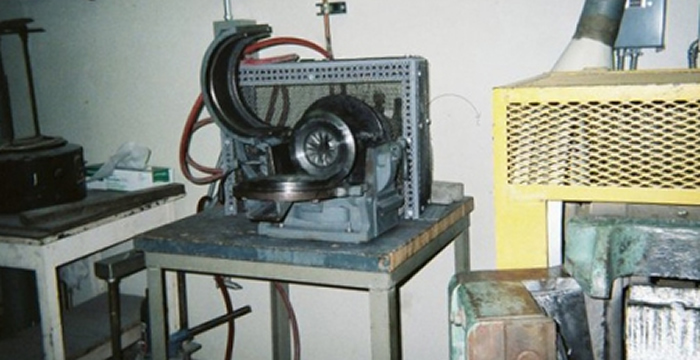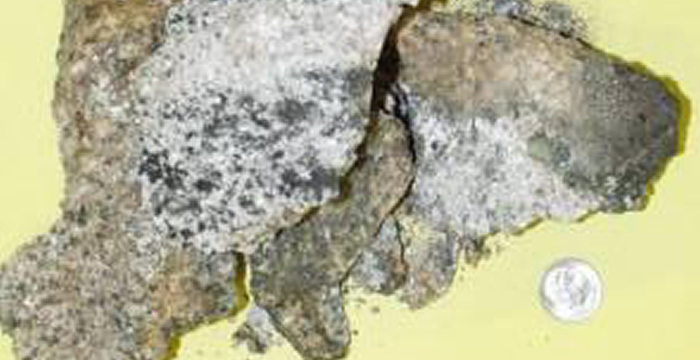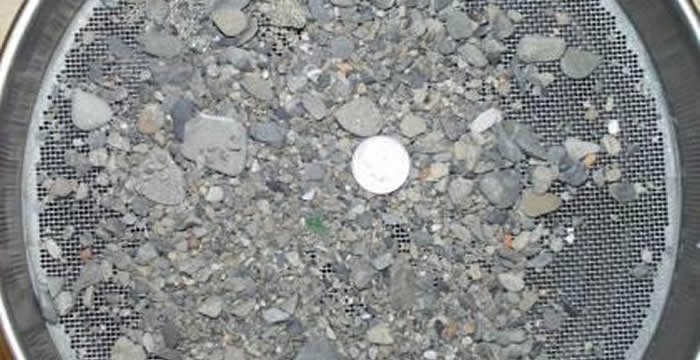Crushing and Sieving
When a sample arrives it is first crushed and sieved. This is to obtain the correct grain size for the rest of the separation process. The ideal grain size is 0.25-0.50mm.
There are two crushing machines available; a jaw-crusher and a disc-pulverizer. Samples are usually run through the jaw-crusher first, and then the pulverizer. If the sample is pebble sized, it is only crushed in the pulverizer. Each machine is cleaned thoroughly after use to avoid sample contamination.
Once the sample has been crushed, it can be sieved to obtain the correct grain sizes. After sieving the sample is bagged according to grain size, usually resulting in three classifications; >.5mm, .25mm-.5mm, and <.25mm. Each bag is labeled with the sample name and grain size. Usually only the .25-.5mm sample is used in the rest of the separation process.
Procedure
- Select two sieves and clean them thoroughly with a brush and a dissecting needle. The goal is to eliminate polymineralic grains, so the coarser sieve should have openings somewhat smaller than the average crystal size in the rock. Use a 0.5 or 0.25 mm screen for the finer sieve. For coarse granite samples, I used 1.0 mm and 0.25 mm screens. The ideal grain size is 0.25-0.50mm.
- Clean the jaw crusher and pulverizer thoroughly with pressurized air and a wire brush. Be sure to clean the catch trays for both the crusher and the pulverizer.
- Set the crusher jaws about half a centimeter apart. Make sure that the catch tray is in place. Crush the sample and pass it through the sieves. Put a magazine or piece of wood over the top of the crusher so that sample material does not fly out and hit you.
- Sieve the sample to remove the grain size you want. Crushing the sample again will crush the grain size you want. This will reduce the amount of the grain size fraction you want.
- Reset the crusher jaws so that they are two or three millimeters apart. Collect the material from the upper sieve and crush it again, then pass it through the sieves.
- Set the pulverizer discs about two millimeters apart. Pass the sample through it, a few grams at a time, and pour it through the sieves. Again, make sure that the catcher tray is in place before pouring in the sample.
- Repeat the last step two more times, each time passing the result through the sieves and putting only the too-coarse fraction back into the pulverizer.
- Reset the pulverizer discs to be about a millimeter apart. Pass the sample through the pulverizer and pour it through the sieves.
- Repeat the last step two more times, each time passing the result through the sieves and putting only the too-coarse fraction back into the pulverizer.
- Reset the pulverizer discs to be very close together. Pass the sample through the pulverizer and pour it through the sieves.
- Repeat the last step two more times, each time passing the result through the sieves and putting only the too-coarse fraction back into the pulverizer.
- There should only be a few grams of sediment remaining on the coarser sieve. These grains will be mostly flakes of feldspar and mica. Pour these into a sample bag over a clean tray and label the bag twice with the sample name and the grain size.
- Pour the desired grain size fraction into another sample bag. Again, label the bag twice with the sample name and the grain size.
- Also pour the fine fraction into a third sample bag, and label the bag twice.





